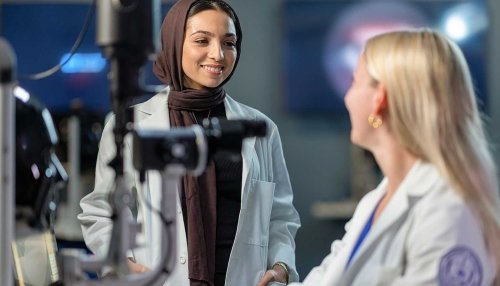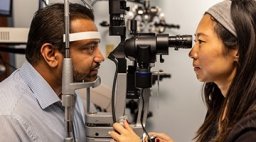At the Chicago College of Optometry (CCO), we empower aspiring optometrists within a nurturing student-focused environment.
Empowering Aspiring Optometrists
We inspire the next generation of optometrists to craft successful careers within a nurturing student-focused environment that emphasizes professionalism, teamwork, mutual respect, and immersive hands-on experiences.
Key features include:
- Personalized Attention: Low student-faculty ratio for your success
- Interprofessional Opportunities: MWU's focus is on healthcare fosters collaboration across disciplines
- Extensive Patient Care Experiences: Gain valuable hands-on experience through a variety of patient care opportunities
At the Chicago College of Optometry, you will gain expertise for a fulfilling career contributing to the well-being of others by providing essential eye care.
Why Our Program is Exceptional
- Our Location: We are a small, safe campus, located close to many reputable hospitals in Chicago.
- Our Reputation: MWU students get to see many different types of patients at our student-run clinics, from children in need of vision therapy to adults with dry eyes. Our university also offers more than 30 student clubs, making it easy to network with students across many healthcare fields.
- Our Faculty: From the very first interview at MWU to the lasting mentorship that extends beyond graduation, students consistently describe our faculty members as compassionate and approachable.
- What We Care About: Above all, we value relationships. Not just student-to-faculty or student-to-patient, but mentorships, too. First- and second-year students are paired together each year, which helps them learn from each other.
- What Sets Us Apart: Our small class sizes offer students more opportunities for one-on-one attention with faculty. We also have state-of-the art facilities and labs.
Your future starts at CCO
Learn More
Learn more about the requirements and find quick links to relevant information to guide you in your decision-making process.
- Bachelor's degree from a regionally accredited institution
- Completion of course prerequisites with a grade of C (not C-) or higher
- Minimum overall cumulative GPA and science GPA of 2.75 on a 4.00 scale
- OAT or other entrance exam scores must be submitted by April 30th.
- Scores older than five years are not acceptable
- Additional information on the OAT may be found online at www.opted.org
- Two letters of recommendation
- One letter must be from a practicing optometrist
*Subject to change
Applicants are strongly encouraged to apply early in the cycle. Applications are considered on a first come first served basis only until all seats are filled.
Students must apply for admission via OptomCAS by April 1st. Due to the large number of applicants and the limited number of seats available, students are strongly encouraged to complete the application early in the cycle.
Mission
The mission of the Chicago College of Optometry is to develop competent individuals who embrace lifelong learning through the pursuit of excellence in education, research, scholarship, and patient care for a diverse society. The College's educational programs emphasize and promote public health, leadership, ethics, professionalism, compassion, commitment, collegiality, and sense of community.
Vision
The Midwestern University Chicago College of Optometry has the vision to
Deliver an exceptional optometric educational experience utilizing our unique multi-health professional setting and cutting-edge technology.
Provide our students with the knowledge and skills to deliver the highest level of professional, ethical and compassionate eye and vision care.
Recruit qualified students; promote lifelong learning, community outreach, and innovative research; and develop leaders in the profession and communities.
Goals
The Midwestern University Chicago College of Optometry will pursue the following goals:
- Deliver a comprehensive Doctor of Optometry degree program that prepares graduates for contemporary practice and encourages and fosters advanced training, in order to serve the interests and needs of the broader community.
- Present an innovative optometry program with faculty committed to learning and teaching the current research and evidence based medicine applications using technologies to provide an exceptional educational experience for students.
- Develop and support the faculty and students in the commitment to research and scholarly activities and excellence in patient care.
- Graduate students who have achieved the learning outcomes as defined by the Faculty.
- Improve patient care through promotion of interprofessional educational programming and the Midwestern University One Health Quality Initiative.
- Foster a commitment to professional, collegial, and ethical practices in patient care while promoting public service to diverse communities.
- Develop a high quality program appropriate for optometry residents at an affiliated or Midwestern University sponsored accredited optometry residency site.
- Serve the eye and vision healthcare needs of Downers Grove and neighboring communities through the Midwestern University Eye Institute.
- Provide and encourage lifelong learning and support services to the optometric profession.
- Develop leaders in the optometric profession and the healthcare community.
- Female: 68%
- Male: 32%
- Average overall GPA: 3.50
- Average OAT scores: 319
- Top home states/countries: Illinois, Ohio, Michigan, Canada
NBEO report: Comprised of students who met the graduation requirements of the program (completed courses, passed part I and took part II of NBEO) from October 1st - September 30th of the graduation year, regardless of initial matriculation date.
The following scholarships are offered to incoming Chicago College of Optometry students. Once an offer of admissions is accepted, your application will be evaluated by our Admissions committee for consideration. The evaluation process will begin in December, and scholarship offers will be distributed on a first-come, first-serve basis. The award amounts vary based on the available funds each year.
CCO Academic Scholarships
These scholarships are awarded to applicants who demonstrate academic excellence in their pre-optometry school studies, possess a minimum overall GPA of 3.4 or higher, a minimum science GPA of 3.2 or higher, and exhibit the ability to contribute significantly to the CCO community and the optometric profession.
CCO Achievement Scholarships
These scholarships are awarded to candidates that, in addition to academic GPA, have demonstration of leadership in various areas and/or exhibit the ability to contribute significantly to the CCO community and the optometric profession.
Additionally, there are public scholarships and awards that are available to students who are currently enrolled at CCO.
The Accreditation Council on Optometric Education (ACOE) has granted the Midwestern University Chicago College of Optometry the accreditation status of “Accredited.” Accredited is a classification granted to an educational program indicating that the program generally meets the Standards for accreditation. For more information, see the ACOE’s website at www.theACOE.org or contact the ACOE at accredit@theacoe.org.
Midwestern University is accredited by The Higher Learning Commission/A Commission of the North Central Association of Colleges and Schools (HLC/NCA), 230 South LaSalle Street, Suite 7-500, Chicago, IL 60604-1413.
Academic Course Catalog
Explore details regarding your specific College/Program (subject to change).
Hear Our Stories
Roman Somogy, O.D., CCO, Class of 2025
"The future of healthcare is going to be interconnected."
Parres Wright, O.D., FAAO, Associate Professor, CCO
“I think (students) see us as not only experts in the field but human beings who actually care about them.”






